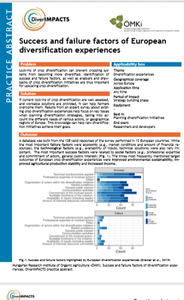
Success and failure in diversification
Researchers examining the factors affecting the success or failure of diversification experiences in agriculture have compiled a database using 128 validated responses from a survey across 12 European countries.
The DiverIMPACTS team is seeking to identify success and failure factors as well as enablers and drawbacks in crop diversification in order to avoid or overcome the lock-ins that can prevent the emergence of more diversified systems.
In a recently produced practice abstract they say the most important failure factors were economic (market conditions and level of financial resources), while technological factors were also very important (input availability and technical solutions). The most important success factors were related to social factors (professional expertise and commitment of actors, general public interest).
Below we list their key findings and recommendations:
- Most of the surveyed diversification experiences, covering both organic and conventional systems, added new crops to the rotation. The number of multicropping and intercropping experiences was also remarkable.
- The most frequent crops added to the rotation were cereals and oilseed crops, legumes and cover crops.
- The upstream value chain levels involved most often in initiatives were seed production, machinery development, breeding and development or organisation of inputs
- The most important aspect, mentioned several times in open questions, was the challenge of processing mixed or new crops.
- Successfully involving the downstream value chain level therefore plays an important role. Involving sales, logistics and marketing is necessary to make an initiative successful.
- Two-thirds of the surveyed initiatives were self-funded; nevertheless, initiatives needing adapted material and downstream value chain development might require investments higher than €100,000. In such cases, funding through EU and/or national and regional projects as well as policy played an important role. Policies can be either a key enabler or a drawback, depending on their implementation.
- Human resource-related aspects, like professional expertise, commitment of actors and personal interactions, were crucial for the success of crop diversification initiatives. Key drivers for success are thus people, their knowledge, commitment and interactions.
- During the implementation of an initiative, involving experts or training and motivating actors is essential.
- The upgraded crop rotation systems can be more sustainable and successful if the new crop has no common diseases and pests, but can be cultivated with the existing machinery.
- Do not forget the market conditions, which were considered more important for rotation-only diversification initiatives, while they were hardly relevant for the majority of the crop diversification initiatives, which included multicropping and/or intercropping.
- Remember that rotation alone did not really improve the status of the environment according to respondents; try to combine it with other practices, such as avoiding pesticides, or with other diversification strategies.
For more information:
Last update: 24/05/2023 - ENDURE © 2009 - Contact ENDURE - Disclaimer
